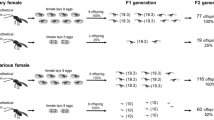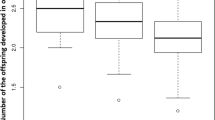Abstract
When host and parasitoid phenologies areunknown the estimation of the generationalpercentage parasitism poses severalmethodological problems. We developed a simplemethod, based on a statistical approach, tosolve that problem. An unbiased estimator wasfound, named μCR, of thegenerational percentage parasitism, and itsperformance was tested through the analysis ofdata from two host-parasitoid systems: Phyllonorycter crataegella (Clemens)(Lepidoptera: Gracillariidae) and Sympiesis marylandensis (Girault)(Hymenoptera: Eulophidae), and Pierisrapae L. (Lepidoptera: Pieridae) and Cotesia (Apanteles) glomerata (L)(Hymenoptera: Braconidae). The μCR estimator proved to be a goodapproximation of the generational percentageparasitism, but its 95% confidence intervalwas very wide. The performance of the μCR estimator was improved and the95% confidence interval was smaller when someinformation on host and parasitoid phenologieswas added. The results suggested that thesmaller interval μCR ± onestandard deviation would contain with a greatprobability the generational percentageparasitism.
Similar content being viewed by others
References
Alleyne, M. and N.E. Beckage, 1997. Parasitism-induced effects on host growth and metabolic efficiency in tobacco hornworm larvae parasitized by Cotesia congregata. J. Insect Physiol. 43: 40–424.
Bellows Jr., T.S., R.G. Van Driesche and J.S. Elkinton, 1989. Extensions to Southwood and Jepson's graphical method of estimating numbers entering a stage for calculating losses to parasitism. Res. Popul. Ecol. 31: 16–184.
Brodeur, J., 1994. Susceptibility of parasitized insect hosts to predators. Norw. J. Agric. Sci. 16: 14–153.
Brodeur, J. and J.N. MacNeil, 1989. Seasonal microhabitat selection by an endoparasitoid through adaptive modification of host behavior. Science 244: 22–228.
Digweed, S.C., 1998. Mortality of birch leafmining sawflies (Hymenoptera: Tenthredinidae): impacts of natural enemies on introduced pests. Environ. Entomol. 27: 135–1367.
Dushay, M.S. and N.E. Beckage, 1993. Dose-dependent separation of Cotesia congregata-associated polydnavirus effects on Manduca sexta larval development and immunity. J. Insect Physiol. 39: 102–1040.
Gould, J.R., J.S. Elkinton and W.E. Wallner, 1990. Density-dependent suppression of experimentally created gypsy moth, Lymantria dispar (Lepidoptera: Lymantriidae), populations by natural enemies. J. Anim. Ecol. 59: 21–233.
Gross, P., 1993. Insect behavioral and morphological defenses against parasitoids. Annu. Rev. Entomol. 38: 25–273.
Harvey, J.A., M.A. Jervis, G.J. Gols, N. Jiang and L.E.M. Vet, 1999. Development of the parasitoid, Cotesia rubecula (Hymenoptera: Braconidae) in Pieris rapae and P. brassicae (Lepidoptera: Pyralidae): evidence for host regulation. J. Insect Physiol. 45: 17–182.
Harvey, J.A., 2000. Dynamic effects of parasitism by an endoparasitoid wasp on the development of two host species: implications for host quality and parasitoid fitness. Ecol. Entomol. 25: 26–278.
Hassell, M.P. and J.K. Waage, 1984. Host-parasitoid population interactions. Annu. Rev. Entomol. 29: 8–114.
Papoulis, A., 1991. Probability, random variables, and stochastic processes. McGraw-Hill Publishing Company, New York.
Schopf, A. and P. Steinberger, 1997. The influence of the endoparasitic wasp, Glyptapanteles liparidis (Hymenoptera: Braconidae) on the growth, food consumption, and food utilization of its host larvae, Lymantria dispar (Lepidoptera: Lymantridae). Eur. J. Entomol. 93: 55–568.
Van Driesche, R.G., 1983. Meaning of “percent parasitism” in studies of insect parasitoids. Environ. Entomol. 12: 161–1622.
Van Driesche, R.G. and T.S. Bellows Jr., 1988. Host and parasitoid recruitment for quantifying losses from parasistism, with reference to Pieris rapae and Cotesia glomerata. Ecol. Entomol. 13: 21–222.
Van Driesche, R.G., T.S. Bellows Jr., J.S. Elkinton, J.R. Gould and D.N. Ferro, 1991. The meaning of percentage parasitism revisited: solutions to the problem of accurately estimating total losses from parasitism. Environ. Entomol. 20: –7.
Author information
Authors and Affiliations
Rights and permissions
About this article
Cite this article
Ruiz-Narváez, E., Castro-Webb, N. A simple method to estimate percentage parasitism when the host and parasitoid phenologies are unknown: A statistical approach. BioControl 48, 87–100 (2003). https://doi.org/10.1023/A:1021258000572
Issue Date:
DOI: https://doi.org/10.1023/A:1021258000572




